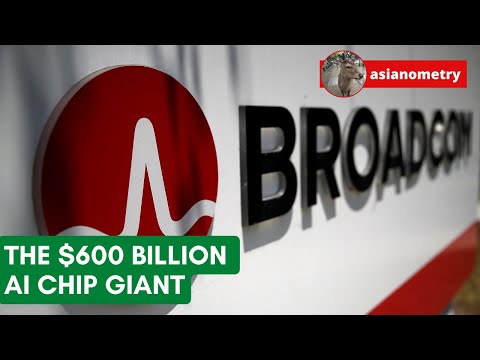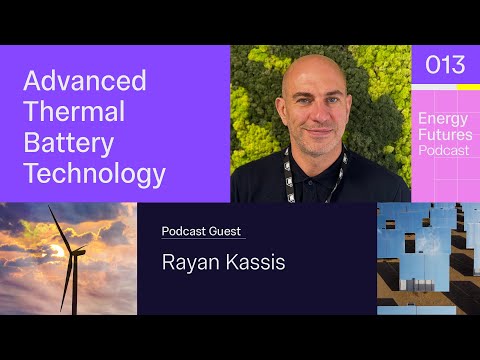Broadcom: The $600 Billion AI Chip Giant

Broadcom is the second largest AI chip company in the world. Thanks to that, the company is the 11th largest company in the world. Over $600 billion as of this writing, bigger than Visa and just behind TSMC.
It is a bit crazy considering that in 2009 the whole company was worth $4 billion. 150 times growth in 15 years is kind of wild. But what is Broadcom? How did they get this big? What do they do? In this video, how a little chip division grew to be a $600 billion AI juggernaut. ## Beginnings The company now known as Broadcom started as a spinoff of a spinoff. In March 1999, the iconic California-based computer-maker Hewlett-Packard decided to split into two. Everything unrelated to computers, IT or printers would be put into the new company - Agilent Technologies.
The new publicly-traded company covered HP's former test and measurement, medical products, chemical analysis, and semiconductor businesses. Accounting for about $8 billion of HP's $47 billion total revenues. Analysts saw this as a necessary re-focusing of a business that had grown too large. In an interview at the time, Agilent's new CEO Ned Barnholt positioned it as a coming-out of sorts from the shadows. Agilent's debut on the markets was one of the biggest IPOs in history up until then. The stock popped nearly 70%.
But the new company struggled to grow in the rough years after the bursting of the Dotcom and fiber optic bubbles. The company's revenues shrank nearly 50% from 2000 to 2001. And soon they started laying people off and selling entire divisions to raise money and simplify the business. So in June 2005, they put up their chip division - called the Semiconductor Products Group - up for sale.
## Spinning Off the Chips There followed a brief auction... Which PE firms KKR and Silver Lake Partners won for $2.65 billion in August 2005. The government of Singapore also co-invested in the deal through their Temasek and GIC sovereign wealth funds. Singapore had been a partner with Hewlett-Packard since 1970, when HP first chose to set up a factory there. It was a glorious time to be in private equity. Some of the biggest private equity deals in history were closed during this 2006-2007 period before the Global Financial Crisis.
Big deals included the utility company TXU (bad deal), the financial services company First Data, and the hospital company HCA. These regularly topped $20 billion in total value. This Agilent carve-out deal was nowhere as large as those monsters. That same month, KKR closed a $10 billion deal for a majority stake in Philips Semiconductor. That was later merged with Motorola's internal semiconductor division Freescale to become what is now NXP. Nevertheless, the Agilent deal seemed like a good arrangement. KKR and Silver Lake believed that the division had the potential to thrive.
Hewlett-Packard's semiconductor division dates back to 1961 when the electronics giant believed that it had to bring component production in-house. Over the years, that group expanded to a range of industries. Some of their more prominent products were FBAR RF filters used for mobile phones’ radios (more on that later); Optical transceivers; And custom chips for HP's lucrative printers to lock you into their ink cartridges; But the semiconductor business changed a great deal in the 1990s. The rise of foundries turned the tables on the economics of owning your own internal semiconductor division.
And despite an admirable attempt to diversify, the division’s cyclical nature and chronically low margins exposed Agilent to losses when times were bad. 17% of the semiconductor division's 2004 revenues still depended on HP itself. In the end, Agilent's management realized that this business was not "core". Thus in December 2005, Avago Technologies emerged into the world. It
was the largest privately-held fabless semiconductor company in the world. ## Hock Tan Avago's first CEO was the division's original general manager Dick Chang. Chang originally joined Hewlett-Packard Labs and became Vice President and General Manager of the Semiconductor Products Division. But a few months after its founding, Avago announced that it had a new president and chief executive - Hock Eng Tan (陳福陽). Hock Tan is of Chinese descent, born in Malaysia. At the age of 18, he won a scholarship to MIT, where he received a bachelor's degree. Then he
went to Harvard Business School to do an MBA. After that, he returned to Malaysia. There, he worked at a number of companies. First, Hume Industries, a cement maker affiliated with a large Malaysian conglomerate. Then a venture capital firm called Pacven Investment.
After that, he returned to the United States. There, he took finance roles at Pepsi and General Motors before landing at the personal computer company Commodore International in 1992. At Commodore, Tan served as vice president of finance and then CFO during the iconic computer company's final days as it struggled with huge losses and low sales. That must have been brutal. After Commodore announced its bankruptcy in 1994, Hock Tan left to become SVP of Finance at a chip company called Integrated Circuit Systems or ICS. ## ICS ICS was founded back in the late 1970s in Valley Forge, Pennsylvania. The company was a design house, meaning that they designed semiconductor products but did not sell them. They did contract design work for larger companies like United Technologies or GE.
In the late 1980s, they developed a hit new product - a silicon timing device or frequency timing generator. Every electronic system needs a timing element, and many older ICs used to use crystals to do that. The silicon timer replaced those crystals with an all-silicon solution, and that was a big deal. It was a huge success and in 1991 they went public.
Hock Tan joined ICS in 1994. Then in 1995, he became CFO. A year after that, he became COO too. Then in 1999, ICS announced a leveraged buyout by its own management team for $257 million. The PE firm Bain Capital and the bank Bear Stearns helped provide funding. Hock Tan became the CEO.
In 2005, ICS merged with another company producing mixed signal chips - Integrated Device Technology in a $1.7 billion deal. Tan became the combined company's chairman. It was then that he was recruited by Silver Lake to be Avago's CEO. ## The Franchise Bloomberg quoted Kenneth Hao; A partner at Silver Lake and now chairman and managing partner - saying about Tan: > He starts with a point of view that the semiconductor industry has matured ... The businesses must be run differently than when they were growing up Tan really likes the idea of focusing on a company's core "franchises" - a word he has used multiple times. In a 1999 interview while he was still CEO of ICS, the silicon timer company, he likened ICS to a franchise: > We have essentially in our business almost a franchise ... in the sense that anybody who wants timing solutions ... would immediately think not just of crystals but of silicon,
and not just silicon but of Integrated Circuit Systems > Our market share in the PC space is extremely high, and that effectively gives us almost a franchise ... We get to be selected in most situations as the first source Years later, he brings up the phrase again in a 2018 interview with the Wall Street Journal: > It's about putting together a very good portfolio of product franchises to create a lot of value ... There’s no long-term vision or ambition other than that ... Frankly, we overinvest to ensure we are way ahead of No. 2 or No. 3 The franchise metaphor is illustrative. The best competition is no competition. Fast food and car dealership franchises maintain small localized monopolies over their areas.
In the old days, the industry's cyclical nature and early growth motivated the old guard semiconductor companies like Motorola and National Semiconductor to launch as many products in as many different fields as possible. But things have since gotten more complicated. Designers are now often more interested in solutions for their systems rather than bespoke components. And foreign competition has flooded the market with options. So Tan's thinking is that today's leading semiconductor businesses need to build and maintain "franchises". To be the instinctive number one choice whenever a designer needs a thing for their system. A small localized monopoly. ## Strengthening the Franchise When Tan takes on a new business, he wants to strengthen that "franchise" as much as possible.
That means a focus on cutting-edge products within the franchise as well as new verticals and applications to expand into. When asked about ICS's growth strategy he said: > We’ll stick to our knitting, essentially, which is silicon timing solutions. Our strategy is to expand applications, and increase market share in digital consumer and communications This means cutting speculative projects like the ones the old guard semiconductor companies used to do. If it does not help the core franchise, chuck it. This approach has more than a few critics. Cuts to R&D expenditure or sales of non-leading divisions have long term implications, since these things take time to bear fruit. The franchises have to come from somewhere, right? Tan correctly points out that he invests considerable resources into existing franchises - milking the cow so to speak. Nevertheless, a company of Avago's style
must - like a hummingbird - be eating constantly in order to appreciably grow. ## Road to IPO Avago began life as a very diverse business. At the end of 2005, the company had five different end markets generating over 10% of sales. This was the convoluted legacy of forty years of diversification at HP. So Tan and his team started organizing this mishmash to create a coherent company focused on its analog, mixed signal, and optoelectronics franchises.
In March 2006, they sold their storage business to PMC-Sierra for about $420 million. In May 2006, they sold off their printer ASIC business to Marvell for about $250 million. Then in December that same year they sold their CMOS image sensor business to Micron Technology for $53 million.
They did one more sale a year later - selling their Infrared operations to the Taiwanese electronics company Lite-On for $20 million. These sales not only raised money to pay down debt, but also slimmed the company's headcount from 6,500 in 2005 to around 3,600 in 2008. By 2008, though Avago's revenue and earnings had not changed all that much since the acquisition, the company had paid off a billion dollars of net debt. The improvement was enough for KKR and Silver Lake to take the company public in August 2008, two years after it first went private. The two PE groups would later sell down their shares in the years after the IPO, eventually realizing a 5x return on their shares. Not bad for a couple years' work. ## The Mobile Revolution The IPO came about at a fortunate time.
2007 and 2008 heralded the introduction of the Apple iPhone and the subsequent smartphone mega-boom. And Avago parlayed their early work in FBAR RF filters to make the most out of the surge. As I detailed in a prior video, RF filters are critical but unheralded parts of the mobile phone. They help the modem separate the data signal from noise - saving on power and improving the user experience.
These filters are actually more like MEMS - tiny tuning forks - rather than Nvidia GPUs. But they are highly specialized - requiring special thin film techniques for certain unconventional materials like gallium arsenide. As I mentioned earlier, HP had been working on FBARs since the 1990s. In 1999,
they released their first commercial FBAR filter. Two years later in 2001, they released the first FBAR filter for the 1900 megahertz band, a GSM band. In 2008, Avago paid $30 million USD to acquire Infineon's BAW RF acoustic filter business and their patents. FBARs are one major subtype of BAWs filter. Infineon's filters were SMRs, another sub-type. In 2010, Avago was first to market with an RF filter for the 4G-LTE bands. LTE
sparked a mobile data revolution across the world, forcing RF filters to have to accommodate increasingly more bands PLUS Wi-Fi and Bluetooth. This greatly increased their complexity, and thus their prices. The RF filter industry grew from about $100 million in 2004 to over a billion in total revenues a decade later. Avago earned a good chunk of that money. At the same time, smartphones got skinnier and more power efficient. This necessitated the consolidation of the many various discrete components of what we call the RF front end - power amplifier, filter, switches, and antennas. Everything short of the transceiver and modem, which is dominated by Qualcomm.
So the mobile smartphone and LTE booms were good for Avago throughout the late 2000s and early 2010s. But by 2013 mobile was some 50% of their revenue, raising concerns of over-concentration. So Hock Tan and Avago went out to buy a new franchise. ## LSI & The Data Center In December 2013, Avago announced that it would acquire LSI Logic for $6.6 billion. I covered LSI Logic and its journey in a prior video. What follows is a brief summary. LSI had been founded by the former CEO of Fairchild Semiconductor - a no-nonsense Brit named Wilf Corrigan.
They raised a little money, engaged a Japanese fab to make wafers for them, and came out with an innovative “master slice" system that helped customers replace entire circuit boards with custom chips. Revenues exploded to nearly $2 billion. However this space had many competitors and times got tough after the Dotcom bubble burst. After Corrigan retired, LSI's new CEO shifted to a fully fabless business model and started developing custom silicon for running data centers and helping to make them more efficient. LSI Logic already had a foothold in this business through their work on hard drive controller chips. They then bulked it up in 2007 with a $4 billion merger with Agere Systems. Agere was a spin-off company from Bell Labs/Lucent that made semiconductors and components for wired and wireless communications networks.
Together with Agere's business, LSI Logic built up a proficiency in enterprise storage systems - networking and storage hardware connected to SSDs or HDDs. In a time when cloud storage startups like Box and DropBox were raising at billion dollar valuations, this franchise attracted Hock Tan's team. And for LSI, they had been in the desert for a few years anyway, a payout would be a good end for them. Avago's acquisition of LSI Logic was like one of those deep sea gulper eels that try to swallow fish way bigger than them.
In 2013, Avago produced $2.5 billion in revenue. Their market cap was just about $12 billion. Only $1 billion of the $6.6 billion purchase price was their own cash. Their PE partner Silver Lake invested $1 billion and the rest, $4.6 billion, was borrowed. So again, Hock Tan and his team started cutting expenses and paying off debt.
In May 2014, they sold LSI's flash memory solutions - which includes their PCI Express flash solutions as well as controller chips for solid state drives - to Seagate for $450 million. Then in November 2014, they sold LSI's network chip unit, called Axxia, to Intel for $650 million. The unit's chips help internet service providers and data centers monitor and manage traffic over networks. ## Broadcom & Brocade A year after that, Avago struck another, far larger deal - the venerable analog chip company Broadcom. Avago had tried once in late 2014, but couldn't agree on price. But the LSI acquisition drove up Avago's stock and gave it a richer currency to do a better deal.
So in April 2016, Hock Tan called up Broadcom's management again with an offer, then tried to hash out a deal right then and there. From start to end, it took a month and a half. The $37 billion acquisition was the biggest technology deal up until then. Avago paid a nice 28% premium on Broadcom's share price, which was then already at a 9-year high.
Broadcom is a storied name in semiconductor history. Founded in 1991, they produced analog system-on-chips for high speed communications equipment like cable modems and TV set-top boxes. So throughout the 1990s, they grew with the rise of cable operators like Comcast and broadband internet. In the 2000s, they entered a series of other markets like enterprise switches and networking. Broadcom was another gulper eel type deal. Its revenues in the prior year were nearly twice the size that of Avago's.
As part of the deal, Avago agreed to take Broadcom's name and add Broadcom co-founder Henry Samueli to its board. It reminds me of those type marriages between a new-money family and a family that is poor but with a long and prestigious name plus a castle. Little over a year later, Broadcom acquired another storage networking company Brocade for about $6 billion. Again the cycle restarted, cutting expenses and paying off debt. We don't need to rehash this. ## Qualcomm So in just a few years, Avago/Broadcom gathered a great bunch of assets. It is a big company version of buying properties on mortgage, fixing them up, renting them out, and then paying down the debt aggressively. Rinse and repeat for a few times over.
The issue though was that after Broadcom and Brocade, there were not many targets left big enough to move the needle. But you miss 100% of the shots you don't take, so Tan went right for the prom queen - Qualcomm. I also covered this saga in a prior video, but this is the summary. On November 6th 2017, Broadcom offered $103 billion - an offer immediately rejected by the Qualcomm board as too low. They tried to engage but was rebuffed - so they went direct to Qualcomm shareholders in an attempt to swap out the board. In January 2018 Qualcomm filed a notice with CFIUS to block the acquisition.
CFIUS is a committee overseeing national security issues on mergers. CFIUS highlighted concerns about Broadcom's reputation of cutting R&D, feeling that it would extinguish Qualcomm's chances of competing in 5G technologies against Huawei and other Chinese companies. In response, Broadcom re-domiciled itself out of Singapore to the United States.
Then-President Trump held a public conference with Hock Tan on this. The re-domiciling would have presumably invalidated CFIUS's jurisdiction. But the Trump Administration ended the whole kerfuffle when it issued an executive order blocking the deal. That happened six years ago - time really flies. Qualcomm's market cap has since risen
to a number above Broadcom's offer price due to surging revenues from the COVID technology boom. But the stock price hasn't moved all that much since in part due to the post-COVID hangover, Huawei competition, and what not. As of this writing, Qualcomm's market cap is $190 billion. Looking back, I feel like the Qualcomm shareholders would have preferred the growth from having Broadcom shares.
But on the other hand, CFIUS's point was that they wanted to retain Qualcomm's ability to compete in certain wireless markets like 5G. Broadcom would have supposedly snuffed that out. It wasn’t a money thing. Yet Huawei is still dominant in 5G and Qualcomm's modem work seems to be more in the news for fighting Apple on royalty payments. But I certainly feel that the Broadcom acquisition would have snuffed out Qualcomm's attempts to compete in Arm-flavored laptop chips like Snapdragon X. On the whole,
I still think it's a good thing that Qualcomm stayed independent. ## The AI Boom Blocked from further growth in silicon, Hock Tan and Broadcom have since turned to acquiring software companies. This includes CA Technologies, Symantec, and VMWare. Basically running the same processes, pulling out the franchises, cutting expenses, and paying off whatever debt incurred for the buy. But until ChatGPT came out, there were always questions of what was next. What thing can they get next to take them to the Holy Land? The answer had been inside them all this time.
When Avago/Broadcom acquired LSI Logic in 2013, they also acquired a small custom silicon design division that helped external customers produce their own chips for the data center. When Google started on the first iteration of their own chips - the Tensor Processing Unit or TPU - they did not need that many of them. So in 2016 they engaged Avago/Broadcom to help design and produce the chip for them. Why did Google do this? Because custom silicon design teams are expensive. You not only pay a lot for talents, but also EDA tools and IP for them as well. Unless your volumes are massive,
it is better to engage LSI or Avago to do the design based on your spec plus other value-adds like testing and packaging. Back in 2016 when the TPU relationship presumably began, custom silicon was quite small for both sides. Broadcom's revenues from that year was estimated at about $50 million or so. But it grew over time and by 2020, Broadcom’s TPU revenues were estimated at $750 million. Together, the two companies have made several new TPU iterations on faster nodes. When ChatGPT blew up in November 2022, it started the current AI boom, with everyone from startups to tech giants getting into generative AI. Many of these players hit compute bottlenecks, because nobody not even OpenAI expected ChatGPT to be such a hit.
Google realized that their TPU ASICs gave them a huge competitive advantage in compute over Microsoft, Oracle and others. So they started buying more TPUs, which benefits Broadcom. SemiAnalysis projects that Google will pay Broadcom far more in 2024 for TPUs - something like $8.5 billion. Only some lame computational lithography company called Nvidia makes more from AI chips. That is not counting whatever they make from their relationship with Meta or other giants like Microsoft. But Nvidia isn't going to let Broadcom have that all to themselves. In February 2024,
Reuters reported that Nvidia is setting up their own AI chip design unit. The idea being to leverage their IP and expertise to keep customers from designing alternatives to their profitable H200 and B100 accelerators. Good. Let them fight. ## Conclusion I want to thank Dylan Patel of the aforementioned SemiAnalysis for some clarifying comments on this video.
Dylan is great. He did a piece prior on Broadcom's history that I think would be good companion reading to this one. So what is Broadcom? Friend of the show Digits to Dollars lays it out pretty clear: Broadcom is a publicly traded private equity fund masquerading as a semiconductor company. They have a portfolio of strong technology franchises. They acquire new ones,
slim them down, focus them, and then leverage them to buy new franchises. They grow whenever they buy something new. This time, one of their franchises has stumbled into the heart of the AI boom. That does not mean they won't fight like heck to stay there like with the mobile and cloud booms prior. I reckon
they will invest whatever necessary to keep and extend their position in this gold rush.
2024-04-06 20:31


